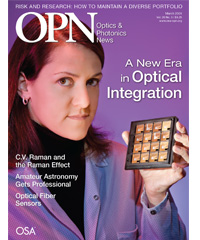
March 2009 Issue
Feature Articles
A New Era in Optical Integration
The Internet is increasingly taxing optical networks, and conventional network architecture cannot provide the scalability required to meet this demand. These authors advise telecommunications professionals to follow the lead of the microelectronics industry— by focusing on integrated solutions.
by J.L. Pleumeekers, P.W. Evans, W. Chen, R.P. Schneider Jr. and R. NagarajanOptical Fiber High-Temperature Sensors
Optical fiber sensors allow researchers and engineers to make accurate, reliable measurements under high-temperature conditions.
by Anbo Wang, Yizheng Zhu and Gary PickrellThe Professional World of Amateur Astronomy
The work of today’s amateur astronomers goes far beyond peering through a telescope on a lonely mountaintop. Thanks to advances in solid-state imaging, software and inexpensive optics, they are collecting professional-quality data and making their own discoveries.
by Patricia DaukantasC.V. Raman and the Raman Effect
Barry Masters describes the life and legacy of one of the most important optical scientists of the 20th century.
by Barry R. MastersDepartments and Columns
Our conversation with Philippe Morin, president of Metro Ethernet Networks at Nortel and OFC/NFOEC keynote speaker.
There are a few things you can count on in this world: The sky is blue; grass is green; and the Sun is yellow ... right?
George Ellery Hale and the Yerkes Observatory
How OSA’s first vice president “licked the Lick.”
Risk and Research: Maintaining a Diverse Portfolio
How can funding agencies strike the right balance between financing “high-risk, high-reward” research—work that is initially uncertain but that could translate into major breakthroughs—and more modest studies that will likely produce solid, incremental results?
Nanoscopy Uncovers Cells’ Secrets
Fluorescent optical microscopy is allowing researchers to image features much smaller than the diffraction limit of visible light.
CREOL’s Tech-Transfer Success Stories
The Center for Research in Optics and Lasers (CREOL) at the University of Central Florida prides itself on its strong focus on technology transfer--and it has the multi-million-dollar success stories to show for it.
Lasing Mechanism Depends on Electron Momentum
A new lasing mechanism was recently reported from a quantum cascade laser that appears to depend on non-equilibrium electrons with high momenta.
A powerful light source for X-ray microscopy
Also in this Issue
Remembering Richard E. Grojean, Robert Hilbert and James L. Fergason


![Manual probe system with needles for test of semiconductor on silicon wafer. [A. Morozov / Getty]](https://opnmedia.blob.core.windows.net/$web/opn/media/images/articles/2025/1125/departments/202511-cover-web.jpg?ext=.jpg)
![Researcher Clara Saraceno in the lab. [Image by Carsten Behler Photography]](https://opnmedia.blob.core.windows.net/$web/opn/media/images/articles/2025/1025/departments/202510-cover-web.jpg?ext=.jpg)
